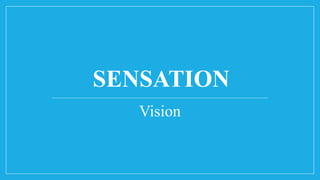
Sensation(vision).pptx
- 2. Sensation Sensation is the process of receiving stimulus energies from the external environment. Stimulus consist of physical energies i.e. light, sound, and heat. Stimulus is detected by specialized receptor cells in the sense organs, which are in eyes, nose, ear, skin and tongue. Stimulus Receptor cells Electrochemical impulse Brain (Physical energy) (Transduction) (Cerebral cortex)
- 3. Senses
- 4. Vision Stimulus for vision is a wave form of radiant energy, that is, light radiates from its source in waves, which we can call light waves. Light has three major characteristics; 1. Wave amplitude indicates its intensity. The amplitude or intensity is its brightness. 2. Wave length is the distance between any point in a wave and the corresponding point on the next cycle. It’s the attribute of light energy that determines the hue or color. 3. Wave purity (whether there is more than one type of wave) produces the psychological experience of saturation. It is made up of light waves all of one length or color.
- 5. Structure of eye Human eyes are 2 inches apart. Because of this, each eye sees the world from a slightly different perspective. Our brain takes the information it receives from each eye and correlates the two images to interpret depth and distance known as binocular fusion. Each eye consist of three concentric layers, each with its own characteristics, appearance, structure and primary functions. 1. Outermost layer consist of sclera and cornea. 2. The middle layer (choroids), contains, aqueous humor, ciliary bodies, Iris, Pupil, Lens and the vitreous chamber. 3. Innermost layer is retinal layer consist photoreceptors (Rods and codes), Fovea, Blind spot, optic nerve and optic chiasma.
- 7. Outer Layer Sclera : The outer layer of the eyeball is a tough, white membrane called the sclera (the white of the eye). Sclera is 1mm thick and tough because of the pressure of aqueous humor. Cornea: The slight bulge in the sclera at the front of the eye is a clear, thin, dome- shaped tissue called the cornea. Light enters the eye through the cornea, the clear, curved layer in front of the iris and pupil. The cornea serves as a protective covering for the front of the eye and also helps focus light on the retina at the back of the eye.
- 8. The middle layer (Choroids coat) The choroid provides oxygen and nourishment to the outer layers of the retina. This thin layer of tissue is made up almost entirely of blood vessels. These blood vessels supply oxygen and nutrients to the outer part of the retina. In short, the choroid is the life source that keeps the retina healthy and functioning.
- 9. Pupil: The pupil is the black opening in the middle of the colored part of your eye (iris). The pupil gets bigger or smaller in response to changes in light. Muscles in the iris control the size of the pupil. Iris and ciliary bodies: The ciliary body produces the fluid in the eye called aqueous humor. It also contains the ciliary muscle, which changes the shape of the lens when your eyes focus on a near object. This process is called accommodation.
- 10. Inner layer ( Retinal coat) Retina contains photoreceptors, the rods and cones which contains chemical that absorb light waves. When they absorb light waves, these chemicals break down, generate a tiny electrical force. If a large enough force is generated, the threshold of neighboring cells is reached and nerve impulse are triggered. These impulses then move to brain. The most critical function of the eye is to convert the information about the world, which is being carried by light waves into neural signals, that the brain can process.
- 11. Photoreceptors: Photoreceptors are specialized cells for detecting light. There are two types of photoreceptors: Rods and cones. Rod cells are highly sensitive to light and function in night vision. Rods are more than 115 million in the side area of retina handling low illuminative vision. Cone cells are capable of detecting a wide spectrum of light photons and are responsible for color vision. They are packed in the center of retina as they are about 6 million. This area is called Fovea, it is our area for sharpest vision.
- 12. Blind spot: This region contains no receptor cells at all. Contributing no photoreceptors and is therefor insensitive to light, creating a blind spot where optic nerve leaves the eye. Optic Nerve: The optic nerve is located in the back of the eye and connects the eye to the brain. Impulses produced by the retina are sent to the brain via the optic nerve, where the impulses are developed into images.
- 13. Optic Chiasma: Place in the brain where some of the optic nerve fibers coming from one eye cross optic nerve fibers from the other eye. This enables vision from one side of both the eyes to be appreciated by the occipital cortex of the opposite side.
- 14. • Cornea • Iris Pupil • Ciliary muscles • Lens Retina • Photoreceptors • Optic Nerve Occipital Cortex